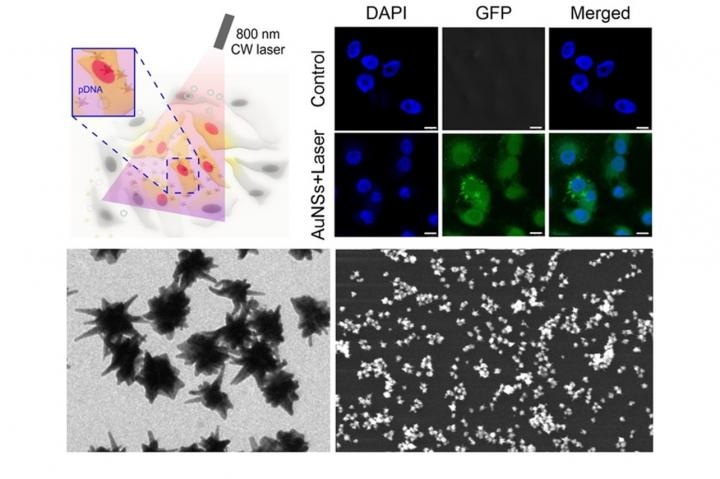Feb 21 2019
Scientists from the Russian Academy of Sciences formulated a new method for star-shaped nanoparticles synthesis based on laser irradiation. A broad range of customizable settings offers an opportunity to form a comfortable environment for different substances delivery to diverse types of cells. The research findings are reported in the Journal of Biophotonics, and the study was supported by the Russian Science Foundation (RNF).
 A new intracellular delivery system. (Image credit: Timofey Pylaev et al.)
A new intracellular delivery system. (Image credit: Timofey Pylaev et al.)
Intracellular delivery systems are of great significance for laboratory and clinical biomedical study. The latest methods based on chemical exposure, viral agents, and microinjections are focused on attaining maximum efficiency while guaranteeing high cell viability. But, not one of the approaches presently known completely fulfills such requirements as compatibility with different cell types and delivered objects, maximum efficiency, minimal toxicity, simplicity of execution relative, and cheapness.
The authors of the new research formulated a new delivery technique with gold nano-stars: star-shaped nanoparticles having sharp spikes. By reducing gold ions on spherical embryos of the same metal, the scientists were able to get them. Next, the nano-stars were placed in the form of individual layers on the plastic surface and covered with cells. Laser irradiation made electromagnetic waves to flow on the nanoparticles surface, thus conveying substances into the cell.
Researchers used pGFP (circular DNA with a gene encoding a fluorescent protein) to examine the efficacy of the developed technique. They targeted delivering these molecules into HeLa cells: human cervical cancer lines. This mixture of model cells and the delivered object was selected because of the frequent use of HeLa cells in biochemical and clinical studies, as well as easy testing since cells to which pGFP was effectively transported are glowing. The efficiency of the new technique for model cells was above 95%. Developing cell-friendly conditions led to virtually absolute survival (about 92%), while after delivering in one of the most common ways—using TurboFect chemical agent—around 75% of the cells endured.
The developed technique is cheaper and simpler compared to traditional commercial systems for the supply of molecules into the cell. The benefits can also include the absence of direct contact of cells with nanoparticles and target substances, which decreases the probability of damage to cells and delivered substances. Furthermore, the spiked surface of nano-stars forms a comfortable environment for cell growth and adhesion (cell attachment to one another and to the surface). This makes the technique appropriate for conveying a broad range of molecules to various cells.
We have developed and optimized a new platform for creating pores in cells based on monolayers of gold nano-stars using continuous laser radiation. Using this method, it is possible to produce highly efficient intracellular delivery of various substances in delicate conditions. We assume that methods using such nanoparticles can be an alternative to existing technologies of intracellular delivery of biomolecules for use in gene therapy, targeted drug application, obtaining modified cell cultures and other biomedical research.
Timofey Pylaev, Study Co-Author, Russian Academy of Sciences.